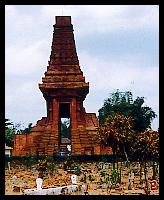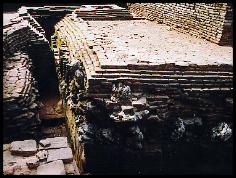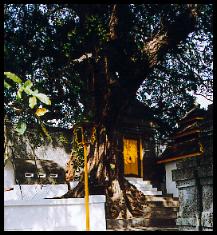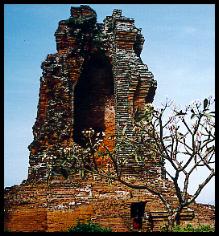

Wringin Lawang, Bajang Ratu, Kedaton or Sumur Upas, Tikus, Siti Inggil, Berahu, Gendong, Prabu Ayam Wuruk, Brhe Kahipuran or Panggih.
The whole of the structures was built about 1350 and spreads out on a surface of 15 km square. The capital of the kingdom of Mojopahit, locked up in a high brick enclosure included palaces, temples, swimming pools, gardens, the cemeteries, etc. A score of monuments is still visible, all are built out of brick, the stone not appearing any more but for the sculptures. Among most interesting, there is the cemetery - Makam Troloyo - which contains the oldest Moslem tombs of Java dated from 1376. Some are struck with six branches sun of Mojopahit announcing conversion to the new religion of certain members of the royal family.
There is a monumental Candi Bentar , a non covered entry door, as one can see many in Bali.
Some claim that it was about the entry of the residence of Gajah Madah, the famous prime minister of the king Ayam Wuruk.

It is a monument
of first half of the 14th century. In fact it is the entrance door to a unit
of now disappeared buildings. This door, a Gopura, is 16 meters height
with a base of 6,00 m x 6,74 m. Illustrations on the basis are drawn from Sri
Tanjung tales, and those, remarquables, of the higher parts are
extracted from Ramayana.
The site of the
building made these last years the object of a beautiful development, and the
cemetery, visible on this image, disappeared today.

Located
in the village of Sentonorejo, one finds the foundations of a
palace there. The release of the terraces and the brick bases
lets think that the building was surrounded by water. It is there
that, according to the legend, last king de Mojopahit, Brawijara
V, became invisible to the sight of his subjects and went up to
the sky.
Work of réabilitations of the site, throughout the decade spent, made it possible to restore a large terrace, to release a cellar of 12,5 m X 8,5 m and 1,6 m in height, and to update a large ditch of 10 m length for 2 m of depth.
Monument
with a central rise in form in mouse (or rat, the mounting of
Ganesha) in the center of the prettiest old bath of Java. It was
built on the remainders of an old ritual bath. The central
structure comprised two circular terraces which were reflected in
water as the image of Mahameru being
reflected in the milk ocean.
Discovered in
1914 and restored between 1985 and 1989, one sees there two small baths and
a great common bath supplied with very many gargoyles in forms of Makara
or buttons of lotus.

A
new temple was built on the original basis. The whole is in a
closed enclosure.
The site is situated 5 km of Trowulan. Its access is clearly indicated since the principal road axis.

It is a large hollow brick monolith, having vaguely the silhouette of a temple of east java, which one says that it is there that ashes of the royal family were preserved.
The building is
13,70 m high, with a 13 m length base for 11 m wide.
This
brick temple which recently has been just restored, was in the
heart of a great number of buildings, now disappeared, but whose
recent excavation of Candi Gendong will be
able to better make known.
This
site, recently updated, is in restoration under an immense
shelter in corrugated iron.
Trowulan, capital of the
Mojopahit empire, contained finally more palace than of temples.
In this enclosure, are some relics related to the family of most
famous king of Mojopahit, Ayam Wuruk.
Located not far from the
precedent, in Sooko, a few kilometers in the west of Trowulan, a
white enclosure locks up a superb
yoni decorated, remains of a mausoleum of a queen of Mojopahit.
![]()